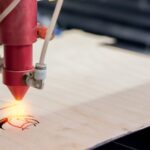
Photo Etching Service also known as photochemical etching or chemical milling, is a highly precise manufacturing process used to create intricate metal parts with exceptional accuracy. It’s a versatile technique that allows for the production of complex designs on a variety of metal types, making it a valuable tool in numerous industries.
Photo Etching Services
| Feature | Description |
| Process | A light-sensitive chemical is applied to a metal sheet, then a mask with the desired pattern is placed over it. The sheet is exposed to UV light, and the exposed areas are etched away, leaving behind the desired pattern. |
| Materials | Can be used on a wide range of metals, including stainless steel, aluminum, brass, copper, and nickel alloys. |
| Applications | Used to create a variety of components, such as: * Electronic components * Medical devices * Aerospace parts * Jewelry * Decorative items |
| Advantages | * High precision and accuracy * Cost-effective for both small and large production runs * Can create complex and intricate designs * Fast turnaround times * Minimal tooling costs |
| Disadvantages | * Not suitable for very thick materials * Can be limited in the types of features that can be created |
How Photo Etching Works
The photo etching process begins with the creation of a digital design, which is then transferred onto a transparent film called a photomask. This photomask acts as a stencil, defining the areas of the metal that will be etched.
Next, the metal sheet is coated with a light-sensitive material called a photoresist. The photomask is placed over the coated metal, and ultraviolet light is shone onto the surface. This exposure hardens the photoresist in the areas protected by the mask, while the unexposed areas remain soft.
The unexposed photoresist is then washed away, leaving the bare metal exposed in the desired pattern. The metal sheet is then immersed in a chemical etchant, which selectively dissolves the exposed metal, creating the final part.

Advantages of Photo Etching
Photo etching offers several key advantages over traditional metalworking methods:
- High Precision: Photo etching can produce parts with extremely fine details and tolerances, often down to a few micrometers.
- Versatility: The process can be used on a wide range of metals, including stainless steel, aluminum, copper, and nickel alloys.
- Cost-Effectiveness: Photo etching is particularly cost-effective for producing complex parts in small to medium quantities, as it eliminates the need for expensive tooling.
- Stress-Free Processing: Unlike mechanical cutting methods, photo etching does not introduce stress into the metal, preserving its original properties.
- Burr-Free Parts: Photo etching produces parts with smooth, burr-free edges, eliminating the need for additional finishing processes.
Applications of Photo Etching
Photo etching is used in a wide range of industries, including:
- Electronics: Manufacturing of lead frames, connectors, and other electronic components.
- Aerospace: Production of precision parts for aircraft and spacecraft.
- Medical: Fabrication of surgical instruments, implants, and medical devices.
- Automotive: Creation of intricate parts for automotive systems.
- Decorative: Etching of metal signs, nameplates, and decorative items.
Choosing a Photo Etching Service
When selecting a photo etching service, consider the following factors:
- Experience and Expertise: Look for a company with a proven track record in photo etching and a team of skilled technicians.
- Material Capabilities: Ensure the company can work with the specific metal types and thicknesses required for your project.
- Production Capacity: Choose a service provider that can handle your production volume and meet your deadlines.
- Quality Control: Inquire about the company’s quality assurance processes to ensure you receive parts that meet your specifications.
Conclusion
Photo etching is a powerful and versatile manufacturing process that enables the creation of highly precise metal parts with intricate designs. Its advantages in terms of accuracy, cost-effectiveness, and material versatility make it an indispensable tool for a wide range of industries. By understanding the photo etching process and its benefits, you can leverage this technology to produce high-quality metal components for your specific needs.




